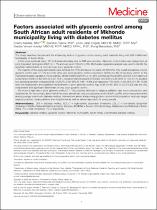| dc.contributor.author | Masilela, Charity | |
| dc.contributor.author | Pearce, Brendon | |
| dc.contributor.author | Ongole, Joven Jebio | |
| dc.date.accessioned | 2022-06-21T08:09:59Z | |
| dc.date.available | 2022-06-21T08:09:59Z | |
| dc.date.issued | 2020 | |
| dc.identifier.citation | Masilela, C. et al. (2020). Factors associated with glycemic control among South African adult residents of Mkhondo municipality living with diabetes mellitus. Medicine, 99 (48), e23467. 10.1097/MD.0000000000023467 | en_US |
| dc.identifier.issn | 1536-5964 | |
| dc.identifier.uri | 10.1097/MD.0000000000023467 | |
| dc.identifier.uri | http://hdl.handle.net/10566/7527 | |
| dc.description.abstract | This study examines the rate and the influencing factors of glycemic control among adult residents living with DM in Mkhondo
Municipality of South Africa.
In this cross-sectional study, 157 individuals attending care for DM were recruited. Glycemic control status was categorized as
poor if glycated hemoglobin (HbA1c) > 7% and very poor if HbA1c ≥ 9%. Multivariate regression analysis was used to identify the
significant determinants of poor and very poor glycemic control.
The majority of the study participants were females (84.71%) and above 45 years old (88.55%). The overall prevalence of poor
glycemic control was 77.71% (n=122), while very poor glycemic control occurred in 50.6% (n=80) of the study cohort. In the
multivariate logistic regression model analysis, African traditional [AOR=0.15; 95% confidence interval (95% CI) 0.04–0.57], fast food
consumption (AOR=5.89; 95% CI 2.09–16.81), elevated total cholesterol (TC) [odds ratio (OR)=2.33; 95% CI 1.50–5.17], elevated
low-density lipoprotein cholesterol (LDL-C) (AOR=5.28; 95% CI 1.89–14.69), and triglyceride (TG) (AOR=4.39; 95% CI 1.48–13.00)
were the independent and significant determinants of poor glycemic control. Age (AOR=0.46; 95% CI 0.23–0.92) was the only
independent and significant determinant of very poor glycemic control.
We found a high rate of poor glycemic control (77.71%) possibly attributed to religious affiliation, fast food consumption, and
dyslipidemia. On the contrary, about half of the study sample had very poor glycemic control (HbA1c ≥9%), which was predominant
among younger cohort with diabetes mellitus. Interventions aimed at improving glycemic control in this population must also target
religious practice, dietary patterns and dyslipidemia as well as tailored-approach for young people. | en_US |
| dc.language.iso | en | en_US |
| dc.publisher | Lippincott, Williams & Wilkins | en_US |
| dc.subject | Diabetes mellitus | en_US |
| dc.subject | Blood sugar | en_US |
| dc.subject | Mkhondo municipality | en_US |
| dc.subject | Adult residents | en_US |
| dc.subject | South Africa | en_US |
| dc.title | Factors associated with glycemic control among South African adult residents of Mkhondo municipality living with diabetes mellitus | en_US |
| dc.type | Article | en_US |

